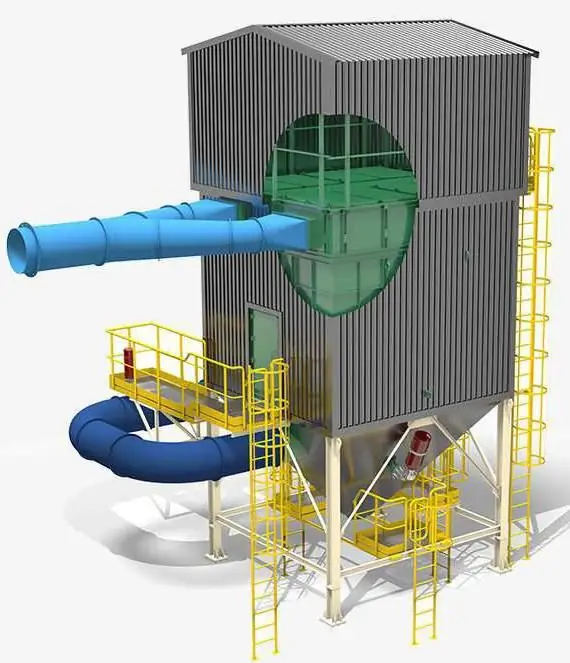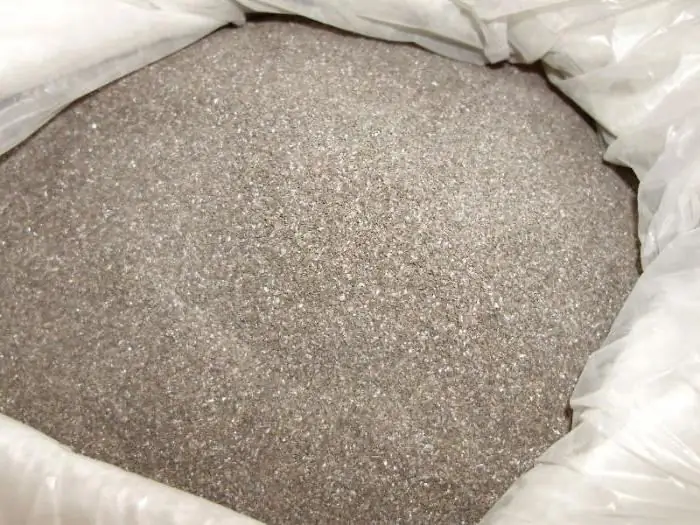2025 Author: Howard Calhoun | [email protected]. Last modified: 2025-01-24 13:10:37
Abrasive materials are characterized by the ability of effective mechanical action. With their help, dirt is removed, plaque is removed, surfaces are cleaned of rust and paint. The working element, in fact, are abrasive granules, which can have different shapes and sizes. One type of such granules is abrasive dust, which can be of factory origin or be the result of processing, waste, etc.

Abrasive dust overview
Dust can have different characteristics and origins, but in most cases it is an undesirable product of the processing of metal and wood products. As a rule, abrasive powder is released in the process of performing grinding and polishing work. Dust can be generated both in domestic surface treatment and in large volumes during industrial operations. In both cases, metal abrasive dust is formed as a result of the destruction of the main processing material. Most often, such waste is left by abrasive discs during mechanical action on the target surface to be treated. At the same time, the dust is not always metallic - usually these are combined compositions, which also include particles of abrasives fromrocks.
Material Composition

Products made of ferrous metal are mainly treated with abrasives. These can be future parts for machine tools, and car components, as well as building materials. The basis of any composition of such dust is formed by iron - about 30%. The second in terms of content is usually aluminum oxide - alumina, although its qualities may also vary. The secondary components of abrasive powders include phosphorus, arsenic, nickel, manganese, chromium, etc. Much also depends on which working surface the abrasive dust interacted with. The composition of the released mixture often includes elements of scale, rust and old paintwork. Actually, to combat such layers, the technique of abrasive removal is often used.
Varieties of abrasive dust

Classification is based on several principles for the separation of abrasive particles. In many respects they depend on the method of application of the processing material. For example, if a grinder with a wheel attachment is used, then the resulting dust can be called silicon dust. It is also practiced to use sandblasting machines, which initially use crushed grains of abrasive. They may differ in size and shape, but their task remains the same - removing unnecessary coatings from the surface or ensuring the smoothness of the workpiece. In this case, the final product of processing will be metal abrasive dust, but already indeformed form. It is important to note that, unlike silicon compounds, such dust can be used in further operations, as are metal powders for grinding.
Features

The parameters and properties of the generated dust are determined by the operating conditions and the materials used. For example, in the work at machine-building enterprises, machines are manufactured that require high-precision finishing of surfaces to the desired geometric format. In such processing, coarse-grained dust is formed between the rolled billets and rolls, the size of which can vary from 5 to 10 microns. Usually it is obtained as a result of evaporation of the same scale, which is about 20% by weight. On average, dust emissions at such enterprises are about 200 g per 1 ton of processed rolled metal. If fire cleaning is additionally used, then the volume of abrasive waste can increase significantly. When performing grinding operations in smaller volumes, the formed abrasive dust has a fine-grained character. Such dust particles have a diameter of 0.5-1.5 microns. But do not think that the selection of small particles is safer than large ones. Firstly, the large fraction facilitates dust removal operations. Secondly, already from a medical point of view, fine dust is more dangerous for the respiratory system. Now it is worth analyzing in more detail the question of why it is necessary to combat the free release of abrasive waste during processing.
What is the danger of abrasive dust?

Without an efficient dust extraction system, the production of metal dust will inevitably spread into the air of the workplace. Under such conditions, occupational diseases of fitters often develop. Such ailments include pneumoconiosis, dust bronchitis, asthma, etc. The development of diseases can be the result of regular irritation of the lungs by abrasive particles from both processing tools and structural elements of workpieces. Therefore, it is so important to initially organize systems that will ensure the effective removal of abrasive dust right in the working environment. Depending on the scale and operating conditions, such systems are organized according to different principles. This can be a typical industrial vacuum cleaner connected to a grinder, and industrial ventilation.
Deletion methods
Small abrasive elements from the material processed using surface grinders are usually collected and diverted to special sedimentation tanks. To do this, it is enough to think over the channel for the path of dust movement. Most often, the problem is solved with the help of planes wetted by water. The water shroud carries the powder into a sump equipped with a filter. Further, again, already clean water washes away portions of the settling dust. For greater efficiency, it is possible to provide a drain channel with a ventilation system that will also prevent accidental scattering of the smallest particles. In construction, the already mentioned vacuum cleaner for abrasive dust is more often used, which, at the moment of particle release, sucks them into a special container, preventing them from scattering. More efficient control systemswaste abrasive processing also involves the use of air currents. For example, an ejector can be used to generate flows, which is installed in the center of the separator body.
Conclusion

The production of abrasive particles is an inevitable phenomenon not only in grinding and polishing processes. Even typical cutting of metal with a “grinder” contributes to the formation of such elements. However, it is not always possible to provide a system by which the abrasive dust would be removed automatically. Especially in domestic conditions, when performing one-time repair operations, it is not advisable to purchase the same vacuum cleaner specifically for this. In such cases, personal respiratory protection should be considered first. As for the protection of the surfaces of the room, it will be useful to cover them with a film before starting work. And without fail, ventilation should be organized - at least through the windows to the street.
Recommended:
Wonders of car cosmetics: abrasive polishing

How often many of us sigh sadly, looking at our car, which used to please with mirror shine and rapid speed. The speed remained, but the body … Divorces, cracks, scratches. But not everything is so sad. In such cases, abrasive polishing comes to the rescue
The best dust collector: overview, specifications and operating rules

Ventilation dust collector (UPV) is a device designed for air filtration. The separation of impurities is carried out in special filters
Abrasive powder: production, consumption. Where can abrasive powder be used?

Abrasive powder is mainly used to clean metal surfaces from rust. Most often, for this purpose, its varieties such as cooper slag and nickel slag are used. Diamond powder is used to make abrasive pastes and grinding tools
How to choose industrial vacuum cleaners without a dust bag

The article is devoted to industrial vacuum cleaners without a dust bag. The main selection criteria and the best manufacturers of this equipment are considered
Dust collecting unit (PU). Types of dust collecting units

Many industrial processes are accompanied by air pollution, which necessitates timely cleaning of the workspace to improve sanitary conditions. Ventilation systems, even in industrial design, are not able to provide sufficient performance for the removal of fine particles produced by processing equipment. Therefore, in solving such problems, special dust-collecting units of various types and modifications are used

